
10 Amazing Facts about Native American History for Kids
Native American History
People lived in the United States long before the arrival of Christopher Columbus and the Europeans. These people and cultures are called Native Americans. This article is an overview of Native Americans who lived in the United States.
The first people to live in a land are called indigenous peoples. This means they were the original settlers. The Native Americans are the indigenous people and their culture is the original culture of the United States.
Native American culture spread across the United States and that is notable for its wide variety and diversity of lifestyles, regalia, art forms, and beliefs. The culture of indigenous North America is usually defined by the concept of the Pre-Columbian culture area, namely a geographical region where shared cultural traits occur.
The northwest culture area, for example, shared common traits such as salmon fishing, woodworking, large villages or towns, and a hierarchical social structure. Cultural features, language, clothing, and customs vary enormously from one tribe to another.
Still, there are certain elements that are encountered frequently and shared by many tribes. Early European American scholars described the Native Americans as having a society dominated by clans.
As they live in tribes, each tribe has its own customs, traditions, and culture. However, they share many characteristics and customs among themselves, such as hunting, trading, fighting, and other characteristics that distinguish them.
There are many Native American tribes, as some may say that the number of tribes reached 574, of which, five tribes were distinguished. We will learn about the most important of these tribes through this article.
The tribes were usually divided based on the area they lived in and so were their cultures, such as their religion, customs, and language. Sometimes smaller tribes were part of a bigger tribe. As good as historians can tell, these tribes were fairly peaceful.
That is prior to the arrival of Columbus and the Europeans. There were hundreds of tribes throughout the United States when Columbus first arrived. Many of them are well known, such as the Apache, Cherokee, and the Navajo.
Apache Tribe

The Apache was one of the fiercest Native American tribes. No one is sure what the name Apache meant, but is believed to mean either “enemy” or “fighting men.” Over centuries, the Apache fought their way through many hostile tribes, across much of what would become the western United States.
Eventually, they settled in the mountains of southern Arizona and New Mexico. In the early 1700s, the Apache often fought with the Spanish. These battles were often long and very bloody. Finally, a Spanish leader agreed to stop fighting and set aside certain lands in Texas for the Apache.
To show that the battles were over, an Apache chief buried a hatchet. From this gesture, we get the term “bury the hatchet.”In the early 1800s, the Apache were often in conflict with Mexico.
Their hatred of Mexico was so great that when the United States went to war with Mexico in 1846, the Apache offered American troops safe passage through their lands. The calm between the US and the Apache did not last.
A gold rush brought thousands of miners into Apache land. When the Apache leader, MangasColoradas, was attacked and beaten by miners, the Apache viewed it as a betrayal of the treaty they had signed.
Apache, who were quick to defend their land, fought back against the miners. MangasColoradas was eventually killed. The country in which the Apache established themselves was a difficult place to live in.
It is made up of desert and mountains, and a hot, harsh climate. Years of surviving there toughened the Apache. This toughness and their long history of fighting many other tribes earned them a reputation as savage warriors.
They were among the most dangerous tribes that the US Army ever fought! The next chief after MangasColoradas was the famous Apache warrior, Geronimo. Geronimo spent years fighting both Mexicans and Americans.
Geronimo was never actually an Apache chief. Although he was a fierce warrior, his people considered him too impulsive. He was often too vengeful. They admired his skill in battle, but they did not think he had the qualities of a great chief.
In 1886, Geronimo and fewer than fifty Apaches were surrounded by five thousand troops. At this point, Geronimo was the last Native American who was still resisting US troops. Because he had resisted them so fiercely, US troops viewed him as the evilest of Native Americans.
After their surrender, they were taken to prisons in the southeast. Most of them never saw their homeland again. Geronimo, a proud warrior, spent the last years of his life as a celebrity. He wrote his autobiography and appeared at fairs.
Some Facts about Geronimo: He married the daughter of a famous Apache chief. Cochise Geronimo died after being thrown off of a horse. He played outside in the cold all night before he was found and developed pneumonia, which killed him.
His last words were, “I should have never surrendered. I should have fought until I was the last man.”
Cherokee Nation
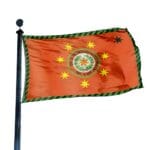
The Cherokee were one of the “Five Civilized Tribes,” located in the southeastern United States. By the 1600s, it is believed that the Cherokee controlled roughly 40,000 square miles in the region of the Appalachian Mountains.
They were located in the present-day states of Georgia, eastern Tennessee, and Western Carolina. The Cherokee Nation Flag is orange.
They fought with the British in both the French and Indian War (1754-63) and the American Revolution (1775-1781). Since they fought with the British, the American colonists saw the Cherokee as a threat to their safety.
They continued to view the Cherokee this way for many years. After the American Revolution, the power of the Cherokee declined. They were also forced to give up some of their lands in the Carolinas.
By the 1800s, they adopted many of the ways of the white settlers on the frontier. They were respected for their advanced civilization. They even had their own alphabet! Their alphabet was developed by Sequoyah, a Cherokee leader.
Each symbol represented a syllable. The alphabet was so easy to learn that almost the entire tribe learned to read within a short time! They also wrote their own constitution, basing their government on that of the United States.
They translated the Bible into the Cherokee language. They even started the first Native American newspaper, the Cherokee Phoenix. In the 1820s, gold was discovered on Cherokee land in Georgia.
At the same time, many white settlers were pouring into the Southeastern United States. When word of the discovery got out, many more settlers came into the area. This increased the desire of the government to get the Cherokee land.
A small number of Cherokees signed a treaty with the government which gave up all of their lands in the eastern United States. Most Cherokee people did not approve of the treaty and eventually took their case to the Supreme Court.
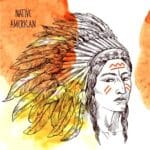
In 1832, the Court ruled in favor of the Cherokee (a remarkable ruling, considering the racism of many Americans at that time!). The Court ruled that the Cherokee nation was “a nation within a nation.”
That meant that the United States government had no claim over Cherokee land. Unfortunately, the state of Georgia and the President, Andrew Jackson, ignored the ruling. Troops were sent into the Southeast to remove the Cherokee, Creek, Chickasaw, Choctaw, and Seminole tribes.
These tribes, who had lived in southeastern North America for centuries, were forced out of their homes. The forced march of the southeastern tribes became known as the Trail of Tears. Cold weather, poor food supplies, and bad treatment caused the deaths of about four thousand Native Americans along the way.
Many of the sick and dying were left where they fell because troops refused to stop for them. They were taken to present-day Oklahoma. At the time, it was considered so desolate that it was unfit for anyone other than Native Americans.
A few Cherokee managed to escape to the mountains of North Carolina. But by 1838, nearly all the Cherokee and other southeastern tribes had been removed from their land. The Trail of Tears was one of the most tragic events in American history.
Chickasaw Tribe
The Chickasaw are a relatively small native tribe. They are located in the Southeast United States and were one of the Five Civilized Tribes. Before they were forced away from their homes during the 1830s, most Chickasaw lived in Mississippi.
The Chickasaw were regarded as fierce warriors. This is probably because they were a small Society and were surrounded by Europeans or other tribes who might pose a threat to them. Many people regarded the Chickasaw as the bravest of the Southeastern Indians.
Training for Chickasaw warriors began in childhood. Boys were taught to fight and also to withstand pain without complaining. War chiefs were very respected and had great authority in Chickasaw villages. They also built fortified towns to withstand attacks.
The Chickasaw never lost a major battle or war. The word Chickasaw translates to “rebel.” I think the name fits! For many years, the Chickasaw fought the French in Mississippi. The French were angry that the Chickasaw traded for weapons with the English in the Carolinas.
The Chickasaw fought the French in two wars; in the 1720s and 1730s. After France was defeated in the French and Indian War, they no longer posed a serious problem for the Chickasaw.
Relations with the nearby Choctaw Indians also improved in the 1700s. When the American Revolution began, the Chickasaw felt that they should support the English. Their good relations with the English had kept them safe for many years.
The colony of Virginia wrote to the Chickasaw nation and threatened to attack if they supported England. The bold Chickasaw responded by telling them not to bother invading their lands—the Chickasaw would meet them halfway and send them back without their heads!
When the Revolution ended, the Chickasaw established relations with the new United States. The Chickasaw endured the same hardships as many other native societies when white settlers began moving into their lands.
Many white settlers moved into Mississippi in the 1820s. During the 1830s, the Chickasaw were forced out of the Southeast along with the rest of the Five Civilized Tribes. Although the Chickasaw were known for their skill in battle, they also had many other skills.
They were known (and still appreciated) for their beautiful baskets. These were often brightly colored with natural dyes, such as sassafras root. Chickasaw generally stayed in one spot but might migrate according to the seasons.
The Chickasaw built both winter and summer houses. The winter house was the larger of the two. The summer house had two rooms and plenty of ventilation to keep the occupants cool. Chickasaw also liked to play. In addition to their homes, they usually built a ball field!
Interesting Facts about Civil War:
Native Americans endured many wars and the loss of their land. Their history is marked by many tragedies. However, those tragedies and defeats have not kept them from making many achievements.
There are many famous Native American chiefs. But Native Americans have also made many other contributions. Below you’ll find a short list of famous Native Americans, who each left their mark on American society.
- Squanto—without the help of the Pawtuxet Indian, Squanto, and the Pilgrims might not have survived their first winter in North America. He gave them food and helped them to grow their own.
- Sacagawea—As a teenage girl, Sacagawea helped the Lewis and Clark expedition into the west by serving as an interpreter. She also saved records and supplies when one of the expedition’s canoes capsized.
- Sequoyah—Sequoyah wrote the Cherokee alphabet. The alphabet was very easy to learn, so most of the Cherokee became literate in a short time.
- Dr. Charles Alexander Eastman—A Sioux author, Dr. Eastman helped found the Boy Scouts of America
- Stand Waite—when eleven Southern states seceded from the Union in 1860-61, some Cherokee supported the Confederacy. Stand Waite was a Cherokee leader and a brigadier general in the Confederate army.
- Ira Hayes—Hayes was a Pima Indian who served in the US Army in World War II. He was one of the American soldiers who raised the US flag over Iwo Jima.
- Will Rogers—Rogers is famous as a writer, actor, and social commentator. He was also of Native American descent and grew up on Oklahoma Indian territory.
- Wilma Mankiller—Mankiller was the first woman elected to be chief of the Cherokee people, in 1985.
- Pocahontas—Even though she was only a young girl, Pocahontas helped the Jamestown colony survive its first winter by bringing them food. She also married a colonist and became a celebrity in England!
- Pontiac—An Ottawa Indian, Pontiac defended the Great Lakes region from a British invasion in the 1760s. He is so respected that Detroit-area car manufacturers named a line of automobiles for him!
- Sitting Bull—The Sioux chief is one of the most famous Native Americans in history. He is responsible for the defeat of Custer at Little Bighorn.
- John Ross—Ross served as chief of the Cherokee longer than any other person. He led the Cherokee during the process of removal.
- Sarah Winnemucca Hopkins—Hopkins published a book called “Life among the Piute’s: Their Wrongs and Claims.” She is believed to be the first Native American woman to publish in the English language.
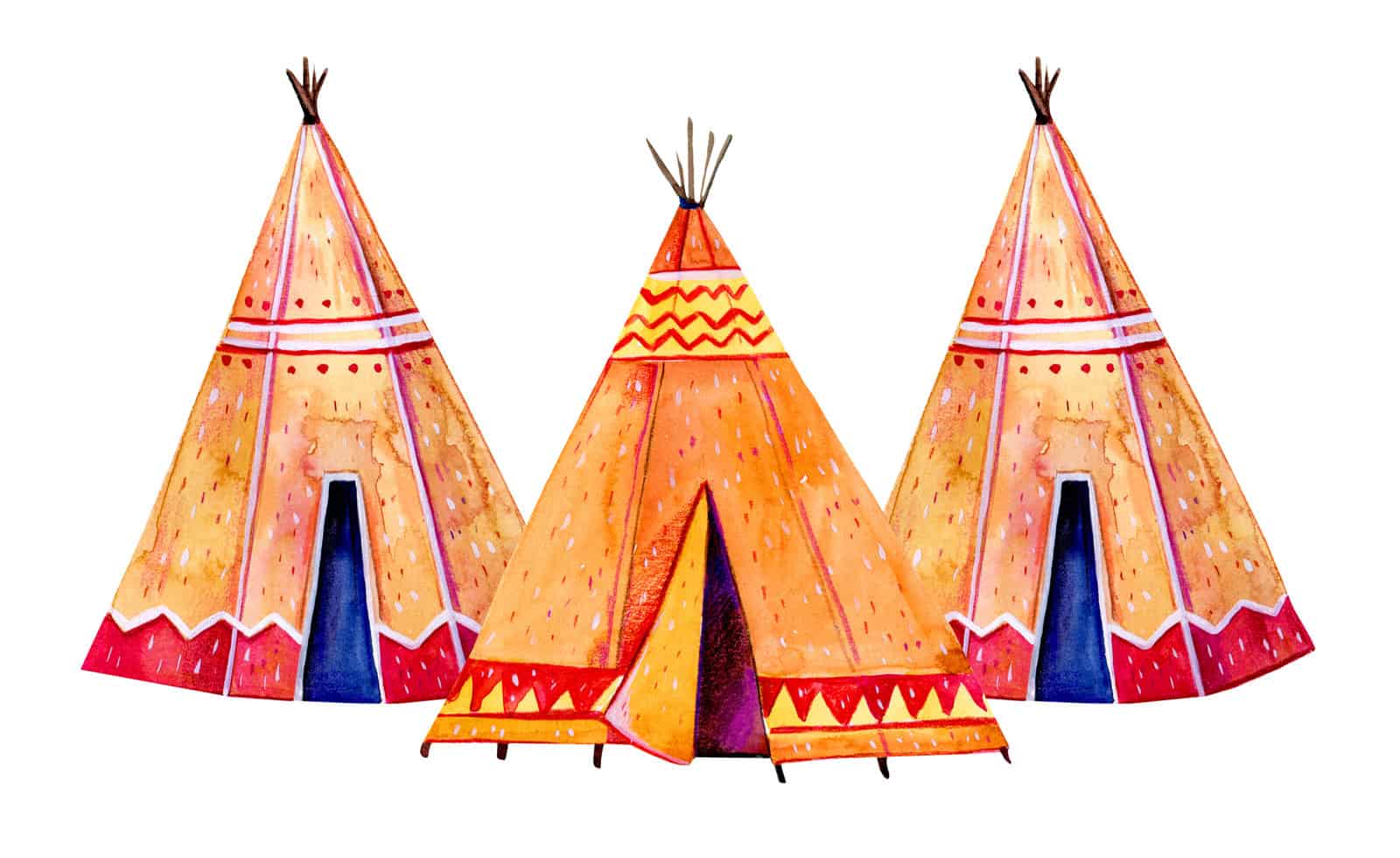
Homes and Dwellings
There were many Native American tribes in North America, and their homes were often very different. Some tribes had to build homes to withstand harsh winters. Others built homes to keep them cool in extreme heat.
No matter where they were located, or what kind of climate they had, Native Americans were very creative in building homes. They used the materials that were available to them to make the best homes for their environment.
In the Great Lakes region, where forests were plentiful, they built homes called wigwams. Most wigwams were eight to ten feet tall. They were made from wooden frames and covered with woven mats and sheets of birch bark.
Often, wigwams were built in a dome or cone shape. Mats covered the floor, and extra mats could be added for warmth. In the Southern Plains, some tribes-built homes are called grass houses. They look similar to wigwams but were made with different materials.
Like wigwams, they were often bent into a dome or beehive shape. Since grass is plentiful on the prairie, grass houses were thatched with long prairie grass. Grass houses could be very large, sometimes as tall as a three- or four-story building! That’s a lot of grass!
In the southeastern United States, they made wattle and daub houses. The first step in building these homes was building a frame, usually from cane, vines, or wood. The frame would then be coated with clay or mud. These homes took a lot of effort to build.
They also required a warm, dry climate in order to dry the mud or clay. Because so much work went into building wattle and daub houses, they were for permanent use. That meant they were well-suited to agricultural people who tended to settle in one place rather than move around.
One of the most interesting types of home is the cliff dwelling. These were built by the Anasazi in the southwestern United States. Believe it or not, they were built along the sides or under the overhangs of cliffs.
Imagine having to climb a ladder to get into your house! The Anasazi did just that—they climbed a ladder onto the roof of their cliff dwelling, and then entered through an opening in the ceiling. Cliff dwellings could be quite complex.
One, known as the Cliff Palace, has more than 150 rooms beneath the rim of a canyon. Another one, Balcony House, can be reached by climbing a thirty-two-foot ladder and crawling through a tunnel. If you’re wondering why the Anasazi would build homes that were so difficult to get into, the answer is simple: for protection!
If they were attacked, they simply had to pull up the ladders, and no one could reach their homes! If you want to build your own Native American home, this is the least you should know:
Set of engraved vintages, hand-drawn, old, labels or badges for Native Americans.

• Wigwams: wooden frames covered with mats or sheets of birchbark
• Grass houses: bent wooden frames thatched with long grasses
• Wattle and daub houses: wooden frames covered with clay or mud
• Cliff dwellings: built onto the top or sides of a cliff with a ladder for entry
Iroquois Tribe
The Iroquois were an alliance of five tribes in the northeastern United States. Those tribes were the Onondaga, the Oneida, the Mohawk, the Cayuga, and Seneca. They were a powerful confederacy for many years and exercised a great deal of influence in the early American history.
The origin of the word Iroquois is unknown, although it is believed to be a combination of an Indian and a French word. The Iroquois were known for their longhouses, which were occupied by several families.
A common room was built at the end of each house, which could be used by all residents. The longhouses were divided by a central corridor. Along each side of the corridor were compartments, which were residences for individual families.
Wampum was a very important part of Iroquois culture. Wampum were cylindrical beads that were made of clamshells. They were used as decorations on clothing, but they also served more significant uses. Strings of wampum were used in mourning rituals.
A person of authority might wear a belt made of wampum beads. They could also be used to record the terms of treaties between tribes. They were even sometimes used as money! The Iroquois had an interesting—you might say a strange! —practice.
Sometimes, however, the adopted tribal members were treated the same as the lost family members, even if they were of a different age or gender! Like many Native American tribes, life for the Iroquois was greatly disrupted by the arrival of Europeans.
They generally had peaceful relations with the French, who did not try to convert them to Christianity as the English did. When possible, the Iroquois tried to remain neutral in conflicts between the English and the French.
They trusted neither group. This worked until the French and Indian War (1754-1763). The Mohawk sided with the English and the Seneca with the French. When the war ended, and the French ceded a very large portion of land to the English, much of it was Iroquois’ land.
The American Revolution also tested the Iroquois Confederacy. Each of the five nations was free to choose its course during the war. Some fought with the English, and some fought with the Americans. When the war ended, however, many Americans set their sights on moving west.
Unfortunately for the Iroquois, this often put them in conflict with the white settlers. The Iroquois maintained their tradition of independence and acting on their own. When the United States went to war with Germany in 1917, the Iroquois Confederacy declared itself an allied nation in the war effort!
Many athletes are good at one sport. It’s rare, however, for an athlete to be VERY good at more than one sport. Jim Thorpe was one of those athletes. He was a rare person who excelled in both baseball and football and won Olympic medals for the track.
Jim Thorpe
Jim Thorpe was born in 1888 in Oklahoma, on Sac-and-Fox Indian land. His given name was Wa-Tho-Huk, which meant “bright path.” His start as an athlete began in the schoolyards of his childhood.
He often ran the twenty miles from school back to his home. While attending the Carlisle Indian School in Pennsylvania, Thorpe happened to pass some students who were practicing track.
Again and again, he watched as students failed to make the high jump. Even though he was dressed in overalls, Thorpe gave it a shot, and cleared the bar! In 1912, Thorpe competed in the Stockholm Olympics, where he won medals.
He won the pentathlon, came in seventh in the long jump, and set a world record in the decathlon. He met the king of Sweden, who told him he was the greatest athlete in the world. Likewise, he returned to the United States and was greeted with a ticker-tape parade in New York City.
Unfortunately for Thorpe, in the summers before he participated in the Olympics, he was paid to play baseball. Many amateur athletes were paid, but most used fake names to get around the rules.
Thorpe used his real name. He was paid very little—just two dollars a game. However, the Olympic rules stated that an athlete who was paid was not an amateur, and amateurs were not permitted to compete in the games.
In 1912, a reporter discovered that Thorpe had been paid to play baseball. Thorpe claimed he had not known of the rules (which might explain why he—unlike other athletes—had used his real name).
He said, “I hope I will be partly excused by the fact that I was simply an Indian schoolboy and did not know all about such things. I was not very wise in the ways of the world and did not realize this was wrong.” In early 1913, Thorpe’s Olympic medals were taken from him.
Thorpe eventually signed with the New York Giants, and eventually played with the Cincinnati Reds and Boston Braves. He also played football for the NFL and served as the first president of the American Professional Football Association.
After leaving sports, Thorpe held a variety of jobs, including working as an extra in Hollywood films. He often struggled to earn enough money to provide for his family. In 1982, the International Olympic Committee restored Thorpe’s gold medals, roughly thirty years after his death.
Maria Tallchief
Maria Tallchief

Maria Tallchief was one of the most accomplished dancers of the twentieth century. She was the first Native American woman to hold the rank of a prima ballerina or the leading woman dancer in a ballet company.
Tallchief was born in Oklahoma in 1925. Her father was an Osage Indian and the family name was actually Tall Chief. From a very early age, Maria’s family saw that she was talented. She began ballet at the age of three!
By the age of eight, Maria’s family left the Indian reservation where she’d grown up and moved to Los Angeles. Her parents had big dreams for both Maria and her sister, Marjorie, who was also a dancer.
While only a teenager, Maria moved to New York City, in the hopes of finding a spot with a major ballet company. It was in New York City that Maria was advised to take the name, Maria Tallchief.
Russian ballerinas were very much admired at the time, and many American dancers took Russian stage names. Maria, however, was very proud of her Native American heritage. She refused to change her name.
In New York, Maria earned a spot with the Ballet Russ de Monte Carlo. The famous choreographer, George Balanchine, choreographed many of the company’s performances. He and Maria became close friends and were eventually married in 1946.
The marriage of a passionate choreographer and a highly talented ballerina produced incredible performances. When Balanchine founded his own ballet company, the New York City Ballet, Maria Tallchief was the company’s first star.
Balanchine created many roles for her. One of these roles, “Firebird,” made her famous. Tallchief also starred as the Swan Queen in “Swan Lake.” Her role as the Sugarplum Fairy in “The Nutcracker” made the ballet one of the most famous in the world.
In the 1950s and 1960s, Tallchief traveled the world as a ballerina. She became the first American to perform in Russia’s Bolshoi Theater. She often starred in television performances, and even had a role in a movie, “Million Dollar Mermaid,” in 1952.
She also performed for the Royal Danish Ballet, the San Francisco Ballet, and the Hamburg Ballet. For most of the rest of her life, Tallchief promoted ballet in Chicago. She founded the ballet school of the Lyric Opera.
She also worked as the artistic director of the Chicago City Ballet. No matter where Maria Tallchief went in life, or how famous she became, she never forgot her Native American heritage.
She was proud of her Osage ancestry. She did not like the misconceptions many people had about Native Americans. In addition to the many awards, she won for her dancing; Tallchief has also been honored for her pride in her heritage.
She is depicted on a mural in the Oklahoma state capital. She was even honored by the Osage Nation with the title Princess Wa-Xthe-Thomba, which means “Woman of Two Standards.”
Native American Art
Native American Art
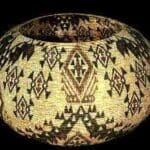
There were many Native American tribes across North America. They each had their own unique culture. Many tribes developed unique art forms, as well.
Since tribes were often very different from each other, their art was often very different from each other. Generally, only native societies that settled in an area for a long period of time pursued art.
Tribes that moved often did not have time for creative pursuits. There were many Native American tribes across North America. They each had their own unique culture.
One of the most common types of art created by Native Americans was pottery. Not all tribes made pottery. The Lakota Sioux, for example, moved too often to carry around heavy pieces of pottery. Most tribes, however, made pottery for its usefulness and also because it was beautiful.
Native Americans often made pottery the same way that artists make it today. They used a spinning wheel, or they sometimes made coil and pinch pots. Many pottery pieces were decorated with important symbols, such as animals.
Sometimes native pottery recorded important events in the history of a tribe. In addition to pottery, Native Americans also made colorful and beautiful baskets. Basket weaving was a common pastime for native women, who spent long periods of time weaving reeds and cornhusks into detailed patterns.
Baskets served a purpose since they were used to carry vegetables and fruits. They also told a story. Like pottery, baskets could be decorated to talk about tribal leaders or even battles. Blankets were another item made by Native Americans that was both useful and attractive.
Set of wild west American Indian
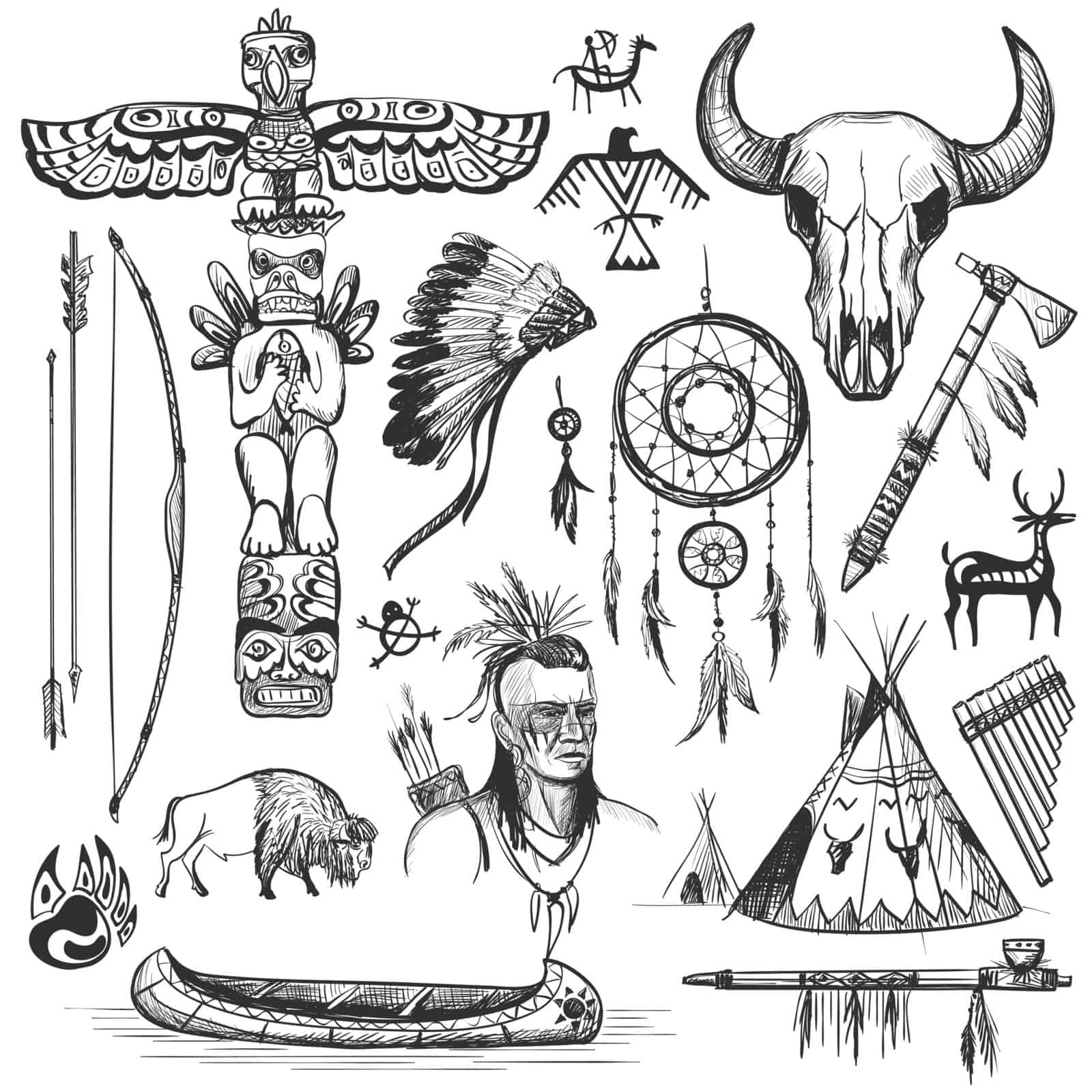
Like baskets, blankets were woven in detailed patterns and vivid colors. It might take days or even weeks to complete a blanket! Many native tribes also made beautiful carvings. Sometimes they carved bones or animal teeth, or even rocks.
These carvings were often of animals. Perhaps the most famous of all Native American art forms was the totem pole. Totem poles were large. In fact, some are more than one hundred feet tall. Totem poles were mostly carved by native people in the Pacific Northwest and Canada.
That’s where the country’s tallest trees can be found! Totem poles were carved with many different faces. Sometimes the faces were of family members, and sometimes they were of animals. Sometimes totem poles were carved with large, protruding wings or beaks.
Totem poles were even used to tell stories or to pass down legends! Imagine it…. a one-hundred-foot-tall storybook with wings and a giant beak! In the Southwestern United States, the Navajo were famous for their sand paintings.
These served a certain purpose. They were made for healing ceremonies. The Navajo believe that the paintings allow them to communicate with spirits who have the power to heal sickness. No matter how beautiful or complex they were, once the ceremony was over, the painting was destroyed. It was simply no longer needed.
Native American Clothing
The clothing of Native Americans varied widely. It depended on what resources were available to them, where they lived, and the time of year. Native Americans who lived in very warm or tropical regions wore very little clothing.
In some cases, they even went naked! In colder climates, more layers of clothing were worn, and they were usually made from thicker materials. One of the most common materials used in Native American clothing was animal skins.
Over many years, Native Americans developed ways of tanning animal hides so that they became soft leather. The leather was used for shoes and clothing, and sometimes as a covering for their homes.
Using animal hides as clothing also served another purpose. Some Native American tribes believed that wearing the skin of an animal gave the wearer some of the animal’s strength and power. Sometimes, an animal’s tail would be left intact and used at the neckline, something like a furry necklace!
For much of Native American history, they also used the plants native to their region for clothing. They even used tree bark, if you can imagine that! It’s hard to imagine, but bark would be stripped from the tree, dried, and shredded.
The fibers gathered from shredding the bark would then be woven into various items of clothing, such as shirts, hats, caps, and aprons. In time, Native Americans began to grow cotton and weave it into cloth. Other fibers such as wool, yucca, and even human hair were sometimes woven into fabrics!
Many items of clothing were also highly decorated, with things like beads, shells, feathers, animal teeth, and fringe. Sometimes decorations were more than simple embellishments. Sometimes decorations could indicate a person’s tribe, a woman’s marital status, or how skilled the person was as a hunter.
By the mid-1800s, Native American tribes began using a material known as “Indian” cloth. This was a type of wool that was woven specifically to be used in trading with Native Americans. It was usually dyed bright, vivid colors.
Unfortunately, later with the increased contact with the Europeans, specifically Americans, meant that Native Americans gradually lost their traditional ways. Living on reservations meant that Native Americans often lost access to the traditional plants and fibers they used in clothing.
Being forced away from their homes meant that Native Americans gradually lost their traditions (in clothing and in other ways). In time, their clothing became no different from that worn by white Americans.
Elderly 99-year-old Navajo Native American woman and her daughter

Native American Entertainment
Native Americans enjoyed sports and games just like everyone else. They spent a lot of their time growing crops and hunting, but they enjoyed their free time. We know from accounts of Europeans, that Native Americans played a variety of games.
They also enjoyed music and entertained themselves with a number of different instruments. Virtually all native tribes played a kind of stickball. Some tribes even included a stickball field in their villages. They used a small ball, roughly the size of a tennis ball.
The ball was tossed into the air, and then numerous players chased it and attempted to hit it with sticks. Even women played this game and some histories record how rough the female players were. A stickball game could become very large, with dozens or even hundreds of people playing.
Sometimes people even bet on the outcome of the game! Many tribes played a kind of hand game. This involved two players hiding bones or sticks under their hands, shifting them back and forth. The other team has to guess where the bones and sticks are.
This game was not only played for fun. Apparently, the game was used to gain land, horses, or cattle. It may have even been used to get a wife! Whatever games Native Americans played; it seems that entire villages participated.
They were not strictly for children. Even elderly family members played games. It also appears that betting on games was commonplace. Music was also widely played for entertainment. European accounts of their encounters with Native Americans often describe enthusiastic music-playing.
Drums were widely used as rattled. Rattles were often made of dried gourds and then filled with things like small rocks or seeds to make noise. Native Americans also made rattles to wear on the body. These were made by stringing shells or animal hooves onto a cord, which would then be worn around the ankle or wrist.
Wind instruments, such as whistles, were also widely played by Native Americans. These were often made from wood, reeds, or hollowed bones. Archaeologists have found many carvings and cave drawings of people playing flute-like instruments. This tells us that it was a popular instrument for Native Americans.
Native Americans were resourceful and very good at using what was available to them. Food was no exception. Wherever a tribe was located, they learned what plants would grow there and how to hunt the animals in the area.
Native American Food
Jumping Fish – Salmon – in Native American Style
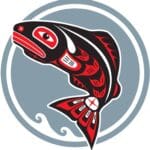
Many tribes survived mostly hunting and fishing. In the Arctic and extreme northern parts of North America, most tribes relied entirely on hunting and fishing. The reason for this was simple—nothing would grow there!
Other tribes hunted mostly big games, like buffalo or caribou. Those tribes moved frequently in order to follow the herds. Almost all tribes hunted at least part of their food. Most tribes hunted deer and rabbits and caught fish in rivers and lakes.
Native Americans felt very strongly that they should not waste food, so they were careful to eat all of an animal that they killed. Agriculture, or farming, was very common among native tribes.
Farming was most common among settled tribes who did not move around very often. It was most advanced in the Southern United States, where the warm climate created a long growing season.
The tribes of the Southeast developed special methods for growing their food. They used irrigation, crop rotation, and planted windbreaks to insure their crops. The main crops that were grown by Native Americans were corn, beans, and squash.
Corn, in particular, was a very important part of the diet of Native Americans. It was referred to as maize by many Native Americans. Most Americans of today are used to corn in shades of yellow. But Native Americans grew a wide variety of corn in many different colors.
They grew red, green, blue, and even black corn! Over the years, corn has been bred to be much sweeter than it was when Native Americans grew it.
Unfortunately, it’s far less healthy now than it was then. In addition to food crops, many native tribes also grew medicinal plants, cotton, and tobacco. Believe it or not, it is estimated that as much as three-fourths of the world’s foods today are food that was originally cultivated by Native Americans!
Native Americans also added to their diets by gathering foods. This meant that they gathered plants that grew in the wild, such as berries, nuts, and herbs. Over time, they learned which herbs could be used to cure sickness or help heal an injury.
Native American meals were simple. Their food was usually eaten fresh, with a little seasoning. Most foods was cooked over an open fire. Corn was prepared and eaten in many different ways. They ate corn-on-the-cob, hominy, popcorn, and even baked cornbread.
Many of these foods are still eaten in the areas where Native Americans passed along their foods and cultures.
Native American Homes
There were many Native American tribes throughout North America. The homes they built were as varied as they were. Their homes often reflected the region in which they lived, their climate, and the nature of their life. Three of the most recognized Native American homes were the teepee, the longhouse, and the pueblo.
The teepee is the Native American home that you’ve probably seen in movies. It is probably the most famous of all Native American homes. The word comes from the Lakota word “thipi,” which means “dwelling.”
These were most common on the Great Plains of the central United States. They were tent-shaped and were usually covered with buffalo skins. Teepees were useful for tribes that moved a lot because they could easily be taken apart.
They were usually about twelve feet tall. Later, however, as the Plains Indians became horsemen, they built them twice as tall. They were meant to be portable and could be taken apart very quickly.
Teepees were simple but cleverly designed. The opening at the top of the teepee had a flap. When fires were burned inside the teepee, the flap could be opened to let smoke escape. Think of it—it was almost like a chimney!
Longhouses were most common in the Northeastern United States. They were usually used by the Iroquois tribes. As their name suggests, they were long—they could be 200 feet long and twenty feet wide. They were usually built with a long, central hallway with a row of compartments down either side.
Individual families lived in the compartments. Longhouses also had a common room at one end which could be used by everyone in the house. Believe it or not, as many as sixty people could live in one longhouse!
Longhouses took a long time to build. Therefore, they were most often used by tribes who tended to stay in one place for long periods.
In the southwestern United States, the Pueblo Indians made homes known as pueblos. They made clay of water, earth, and straw, and then formed bricks. These bricks were dried in the sun and used to make flat, rectangular homes.
These homes looked something like very large shoeboxes. For the sake of protection, Pueblo homes usually did not have doors or windows on the outside. Instead, the home was entered by climbing a ladder and entering through an opening in the roof. The opening on the roof was the only opening a home might have. Pueblo homes could be more than one story, sometimes with additions made over time.
Native American Mythology
There were many Native American tribes in North America, and each one had various myths. Most tribes had myths that involved the creation of the world, as well as numerous heroes and deities.
Most of these stories were passed down orally, as Native Americans did not use written languages. Sometimes stories were entrusted with special storytellers whose job was to pass down legends from the past.
Native American Mythology
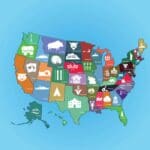
Although Native American myths differed widely, there are certain things that most of them had in common. Most Native American myths and stories involved a creator. This creator was sometimes referred to as the Great Creator or Great Spirit.
There were other spirits who were the personification of natural elements, such as the sun, rain, or the sky. For people who depended on agriculture to survive, elements such as the sun and the rain were very important, so it makes sense that they might be seen as deities.
Many tribes also had beliefs and stories about the creation of the world. Many Native American creation myths tell of the earth being covered by a massive sea. A sea creature—usually a large turtle—dove to the bottom of the sea and returned with a lump of mud which, in time, became the Earth. Other creation stories involve a deity who descends from the sky.
A number of myths also involve a person known as a “trickster.” In these stories, a trickster is usually a mischievous person or animal who is small or weak but makes up for the weakness through being cunning.
In other words, tricksters are characters who succeed by using their wits. Tricksters sometimes did good things, and sometimes they caused problems and did wicked things. Often tricksters were people or animals who deliberately tried to spread as much confusion as possible.
Animals often had special roles in the myths of Native Americans. In many cases, animals help humans in some way, sometimes granting them special qualities, such as courage, or special favors.
The Plains Indians, for example, had a number of stories that involved the buffalo. The buffalo was an essential part of life for the Plains Indians. They hunted it not only for its meat but for its skin and bones as well. They used virtually every part of the buffalo, so it was obviously very important to their culture.
Native American Religions
There were many Native American tribes. They each had their own beliefs. Some tribes had beliefs in common, but there were also many differences. Many Native American religious beliefs were passed down orally, rather than being written down.
This also makes studying Native American religions more difficult. Many native religions were centered on nature. Many tribes believed that all living things—humans, plants, animals, and even the rivers and wind—were all connected.
They believed that these elements of nature were sacred. Many of their religious beliefs involved the origins of things in the natural world, or even the world itself. When most people think of religion, they usually think of a god or a creator of some kind.
Native American religions do not always include such a god. Many tribes seem to have developed an idea of a group of gods. The Sioux have a term—Waken tank—which means something like “greatest sacred ones.”
The Europeans who encountered Native Americans did not understand their beliefs. Since there was no priest or holy book, many Europeans dismissed their rituals and beliefs. They did not see them as a religion.
However, there are a number of things that native beliefs have in common with any other religion. For example, native religions included prayer. Sometimes a prayer was for protection from one’s enemies or healing from sickness.
Although Native American religion did not include someone who served exactly the same purpose as a priest or minister, they did have religious leaders. In Native American societies, this person was known as a shaman or medicine man.
A shaman, was believed, could communicate with the gods. They played an important part in rituals and ceremonies. Because of their ability to communicate with the gods, they were especially respected in native society.
Many native tribes believed that it was possible to anger the gods. When this happened, the gods could take revenge by making a person sick or giving their enemies special powers. To keep from angering the gods, Native Americans might use certain charms.
These could be things that were worn on the body, or they could be objects believed to have magical powers, such as a prayer stick. They might also use incantations and spells. Some tribes even used human sacrifice as a way of keeping the gods happy!
Fortunately, human sacrifice was something that happened rarely! As with any other religion, native religions had prophets. Prophets often experienced visions or claimed to communicate with the spirits of dead warriors and leaders.
Sometimes, prophets introduced new ceremonies and rituals that were meant to give participants special powers. One of the most famous of these was the Ghost Dance.
The Ghost Dance was a ritual that became widespread among the Plains Indians in the late 1800s. It was believed that people who performed the Ghost Dance became invincible!
The Navajo Nation is spread across the states of Utah, New Mexico and Arizona. The Navajo Nation is the largest American Indian tribe, with almost three hundred thousand members. Many of them live on reservations in New Mexico.
Navajo Tribe
The Navajo call themselves “Dine,” which means “the People.” Their land is referred to as “Dine Bikeyah,” or “the land of the People.” After the Navajo settled in the Southwest and gave up their nomadic way of life, they became sheepherders.
Shepherds are still an important part of Navajo life. They are regarded as some of the best herdsmen in the Southwest. The Navajo generally did not live in villages. Instead, members of an extended family lived near each other so that they could help each other grow food and care for their herds.
The Navajo had conflicts with Mexico for many years. When the United States annexed much of the Southwest following the Mexican War, many Navajo hoped that their problems were over.
Many Navajos had relatives who had been kidnapped and held as slaves by the Mexicans. Unfortunately, the US did nothing to free the Navajo slaves, and Mexico continued making slave-raids into the Navajo territory.
1862 was a tragic year for the Navajo. Under orders of the US military, Kit Carson and his soldiers burned Navajo homes and crops. In 1864, there was another wave of attacks led by Kit Carson.
He and his troops rushed through Canyon de Chilly, causing horrible destruction. Eventually, the Navajo were forced away from their land on a 300-mile forced march known as The Long Walk.
They were taken to a prison camp in New Mexico, where many of them were held for up to four years. Many of them died along the way. In 1868, the US government signed a treaty that allowed the Navajo to return and live on a reservation on their own land.
In spite of their poor treatment by the government, many Navajo enlisted in the US Army during World War II. Because the Navajo language was unknown to most people, many of those soldiers became “Code Talkers.”
They used the Navajo language to develop a system of sending coded messages as a way of helping to defeat the Japanese. Navajo Code Talkers were involved in every major battle in the Pacific during World War II. The Japanese were never able to break their code!
Pueblo Tribe
The Pueblo people of the southwestern United States have an ancient history stretching back roughly 7,000 years. For many years, the ancient Puebloans lived in what is known as the Four Corners area.
This is a part of the United States where the corners of New Mexico, Arizona, Colorado, and Utah, touch. At some point in the 1300s, their culture declined. They, then, settled into what is now known as New Mexico and Arizona.
Perhaps the most striking feature of Pueblo culture is their homes. They built adobe homes that were multistoried. Adobe is a mixture of earth, water, and straw. It is extremely strong, and adobe structures have lasted for centuries. They may be touched up from time to time, but they are remarkably durable.
The walls of adobe structures were very thick and made of sun-dried bricks. Many adobe homes were accessible by climbing a ladder and entering through an opening in the roof. The villagers themselves are also referred to as “pueblos.”
In New Mexico and Arizona, the Pueblo people continued to live as they had for centuries. Each pueblo had its own chief, although the most important decisions were made by priesthoods.
One of the things that made Pueblo culture unique was the role of women. Pueblo people were matrilineal, which means that power and status were passed through the women in a family, rather than through the men.
Women-owned the homes and gardens and were generally more respected than women of other native tribes. Many Pueblo women also did much of the farming, which also gave them more respect, because they were producing the community’s food supply.
Far from being one type of people, there are actually twenty-one pueblos. The most well-known of these are the Hopi, Zuni, and Taos. The Taos Pueblo still live; so much as they have for centuries.
There are numerous Native American sites that are UNESCO World Heritage sites, but only the Tao’s Pueblo is still a living community. It is one of the most remarkable examples of Pueblo’s adobe structures.
According to tradition, Pueblo people have lived at Taos for a thousand years. Roughly 150 people still live in Pueblo. As is their tradition, there is no running water or electricity inside the residences.
The Pueblo people are known for their artwork, particularly their pottery. Many people collect pottery painted by the Pueblo and it can be found in many museums. Much of this pottery is adorned with symbols that tell the history of the Pueblo people.
Some of these pieces are so detailed that archaeologists can now use them as a way of piecing together the history of the Pueblo people!
Sacagawea
Sacagawea

The Lewis and Clark expedition into the American west is one of the most legendary events in United States history. It might not have been so successful, however, if it was not for the help of a young Shoshone woman named Sacagawea.
When Sacagawea was about ten years old, she was kidnapped by Hidatsa Indians and taken to what is now North Dakota. She was then sold as a slave to Toussaint Charbonneau, a French-Canadian fur trader. She later became his wife.
In 1804, Lewis and Clark persuaded Charbonneau to join them on their expedition as an interpreter. It was understood that Sacagawea would join the party as well. They wanted her on the journey because traveling with a woman would indicate to Native American tribes that they came in peace.
Shortly before the journey set out, Sacagawea gave birth to her son, Jean Baptists Charbonneau. He made most of the journey on his mother’s back, becoming the country’s youngest explorer!
Sacagawea spoke both Hidatsa and Shoshone. Her husband, Charbonneau, spoke Hidatsa and French. When the expedition met Native American tribes, Sacagawea spoke to them in Shoshone, and then translated that to Hidatsa for her husband.
He then translated the Hiatus to French. Another member of the expedition spoke French, and by relaying the messages through three people, Lewis and Clark were able to communicate with the Native Americans they met.
Sacagawea was valuable not only as an interpreter. But also, as a native of the American west, she knew which berries, roots, and nuts were safe to eat and which ones could be used as medicines. Once, when one of the expedition’s boats capsized in a river, many of their important papers were in danger of being carried away by the current.
Sacagawea quickly jumped into the water and recovered many important papers and supplies. Both Lewis and Clark were impressed by her calmness under stress. At one point during the Corps of Discovery’s expedition, Lewis and Clark attempted to buy horses from a Shoshone band.
Sacagawea served as their interpreter. To their surprise, she found the leader of the band was her brother! She had not seen him since being kidnapped years earlier. Though she could have returned to her people, she chose to remain with the expedition. She continued the journey all the way to the Pacific Ocean.
A few years after the expedition, Sacagawea gave birth to a daughter, Lisette. After the birth of Lisette, the remainder of Sacagawea’s life was uncertain. Most sources say that she died in 1812, shortly after Lisette’s birth.
Pocahontas
Pocahontas

Pocahontas is one of the most famous women in Native American history. Even though all American children learn about Pocahontas in school, there are still parts of her life that are misunderstood.
We know for sure that she was the daughter of Chief Powhatan. Some sources say she was his favorite daughter. She apparently met John Smith, the leader of the Jamestown colony, in 1607.
There is a famous story about Pocahontas saving John Smith’s life. According to the story, Smith was captured by Powhatan’s warriors, and was about to be killed. Pocahontas intervened and rescued Smith.
Some people believe that this event was a type of “adoption” ceremony performed by Indians. Over the years, the story grew to the point that Pocahontas and John Smith were married. This, however, is not true. It might make a nice story, but Pocahontas married someone else!
Pocahontas was about eleven when she met John Smith. This would have been in 1607, the year the colonists landed in Jamestown. She visited the colony often, usually bringing food. Many sources report that Pocahontas’s visits and gifts of food kept the colonists alive during their first year or so in Jamestown.
At one point, John Smith was injured in a gunpowder explosion. He returned to England for treatment. The colonists told Pocahontas and the other Native Americans that he was dead. After hearing of Smith’s “death,” Pocahontas stopped visiting the colony for several years.
The man Pocahontas actually DID marry was John Rolfe was a leading colonist in Jamestown. He was important to the history of the colony because he showed the colonists how to grow tobacco. Tobacco allowed the colonists to finally make a profit.
At some point in adulthood, Pocahontas converted to Christianity and took the name “Rebecca.” After her marriage to John Rolfe, the couple and their son, Thomas, were invited to England by the Virginia Company, which funded the Jamestown expedition.
The Virginia Company believed that Pocahontas would help attract new settlers to Jamestown. In England, Pocahontas was a celebrity! She met many of the most important people of the day. She had her portrait painted wearing stylish English clothes. Not only that, but she even met King James and Queen Anne!
Believe it or not, John Smith was in London at the same time as Pocahontas. They met, and Pocahontas was overcome with emotion and couldn’t speak! (Remember, as far as she knew, Smith was dead).
After she calmed herself, Pocahontas enjoyed talking about old times with John Smith. The Rolfe was in England for several months, but eventually decided to return to Jamestown. Unfortunately, Pocahontas became very sick, and died before leaving England. She was only twenty-two, and had already earned a spot in history!
Pocahontas
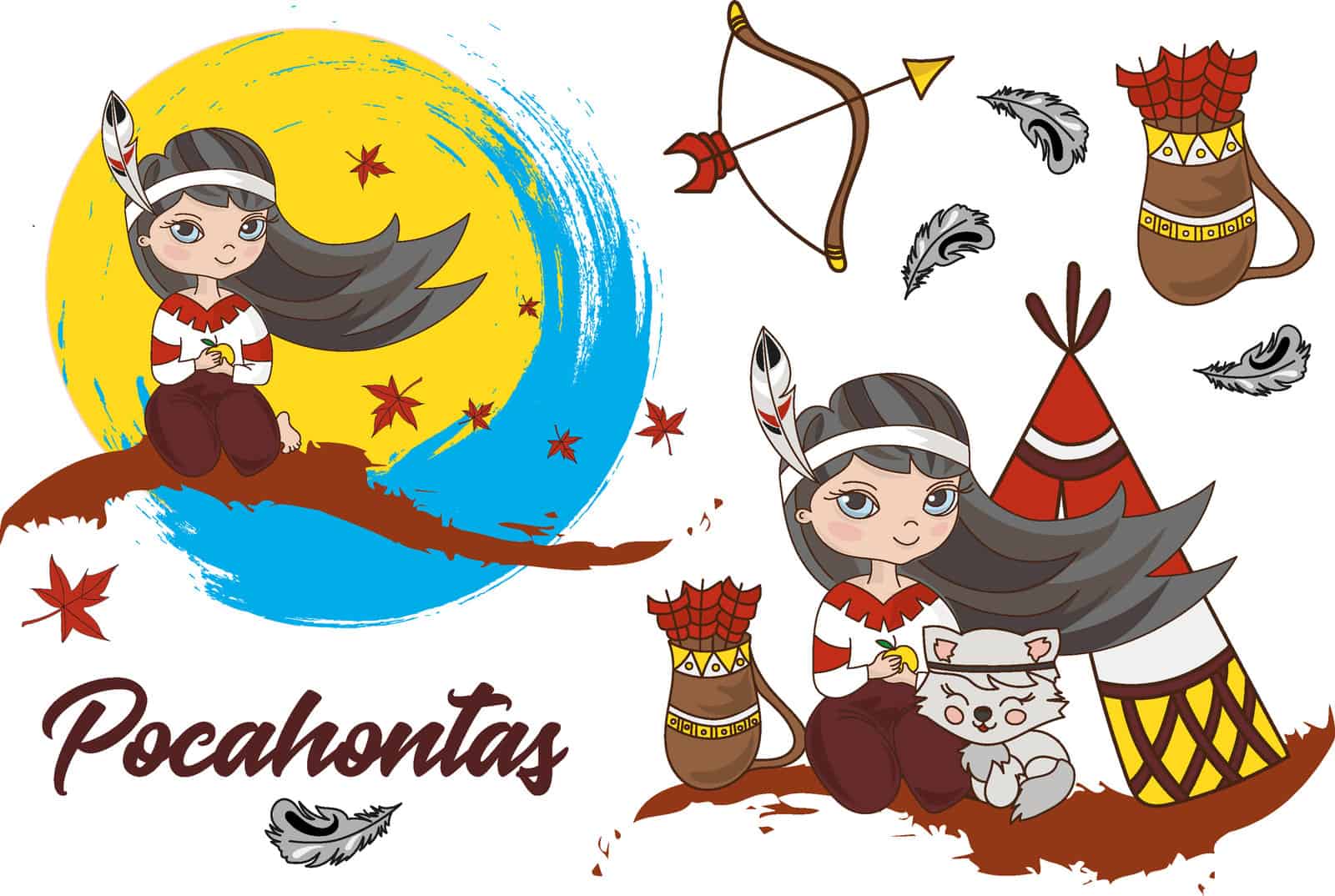
Tribes and Regions
North America is a very large continent. Terrain and climate vary widely across North America. Because of these differences, there was also a wide variety of native tribes.
North America is generally divided into the following regions:
• Northwest Coast
• Plains
• Southwest
• the Arctic
• Southeast Woodlands
• Northeast Woodlands
The Northwest Coast is a small area that includes parts of present-day Oregon, Washington, and southern Canada. The major tribes from this region include the Makah, Nootka, and Tlingit. The Plains include a very large region of the central United States.
It extends from the southern boundary of Canada to parts of Texas. The tribes of the Plains—especially the Sioux—were very good horsemen and fierce warriors. The most well-known of the Plains tribes were the Sioux, Pawnee, Blackfoot, Crow, Cheyenne, and Arapaho.
The Southwest covers an area that included present-day Utah, Colorado, New Mexico, Arizona, parts of Texas, and extends downward into Mexico. Most of the tribes in the Southwest region were nomadic and relied on farming to survive.
The United States fought numerous wars against the tribes in the Southwest, and they developed a reputation for being fearsome fighters. The most famous of the Southwestern tribes include the Hopi, Navajo, Zuni, and Apache.
The Arctic has probably the harshest climate of the regions. It is very large and stretches from Siberia through Alaska and Canada to Greenland. The native people of the Arctic include the Inuit and the Aleut.
The Southeast Woodlands include most of the southeastern area of the United States, from Florida to Texas and extending northward to North Carolina. The tribes in this part of the United States were varied and often developed very complex and advanced societies.
Among these were the Five Civilized Tribes: Creek, Cherokee, Chickasaw, Choctaw, and Seminole. They tended to settle along river valleys and were primarily farmers. Northeast Woodlands is another very large area.
It includes the area between the Mississippi River to the Atlantic Coast, and from the Great Lakes to the Tidewater region of Virginia and North Carolina. Many of the tribes in the Northeast were the native people who first encountered the Europeans in the New World.
Because of that, they played a large part in early American history. The major tribes in the Northeast include the Iroquois, Wampanoag, Narraganset, Creek, Massachusetts, and Nausea.
Remember that even though the tribes might have lived in the same general region and shared things in common, each native society was unique. There were far too many native societies—even in a relatively small region—to attempt to describe their culture according to region.
The Seminoles
For centuries, native people known as the Muscogee lived in what would become the southeastern United States later. They were incorrectly referred to as “Greeks” by English speakers.
After the creek war in 1813-1814 which forced them to give up millions of acres of their land, the most determined creeks fled to Spanish Florida. There, they joined with the descendants of Indians who had lived throughout Florida’s forests for centuries.
These native people referred to themselves as yet’ Seminoles which means “free people”.Eventually, the Indians in Florida came to be known as “Seminoles”. Spain was no longer the powerful nation it once was.
It had very little control over the events in Florida. After numerous attacks on white settlers by Seminoles following the creek war, the United States government sent troops to Florida. The troops were commanded by Andrew Jackson, a tough general from Tennessee.
Many Americans at the time hated Native Americans because they fought with the British in both the American Revolution and the war of 1812. Americans saw Indians as a threat to their security. The Seminoles in Florida also took in runaway slaves. This angered many southern slave-owners.
Explore the previous examples and facts, and you will find yourself getting the necessary knowledge and information to fully grasp the concept of Native Americans. So, keep on visiting our Learning Mole to get more knowledge and information.


Leave a Reply